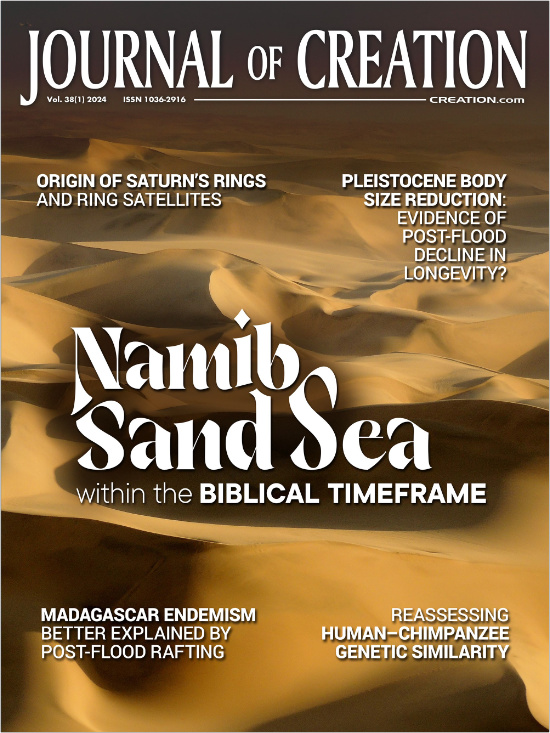Journal of Creation 38(1):51–53, April 2024
Browse our latest digital issue Subscribe
Enantiomeric amplification of L-amino acids: part 7—using aspartic acid on an achiral Cu surface
A study is critically evaluated here which reported an enantiomeric excess (e.e.) of aspartic acid when sublimed at low pressures and ~460 K when deposited on achiral Cu(111) surfaces. Different levels of initial e.e. increased or decreased when continually exposed to the sublimate, converging to a D/L ratio of 16. This was claimed to offer a possible natural solution for the origin of L-only amino acids (AAs) in proteins. The study used a single AA known to be among the few able to crystallize as conglomerates. However, the results only occurred upon careful guidance by chemists. A very high concentration of Asp was necessary but would not have arisen naturally at 2 × 10–10 torr and 460 K in any plausible terrestrial setting. No e.e. was observed at temperatures around 400 K and a few degrees above 460 K, Asp degraded thermally. Therefore, the experiments were deliberately terminated within 55 minutes at an optimal temperature. Availability of sizeable amounts of an ideal pristine surface in contact with the sublimate is not realistic. Furthermore, such homochiral clusters do not form for most other biogenetic AAs. Crucially, contact with water at this high temperature would have subsequently rapidly racemized the e.e., especially in the presence of Cu2+ chelating metal.1,2
Auto-amplification of aspartic acid on an achiral Cu surface
This is part 7 of a series critiquing possible explanations for a natural origin of the L-amino acids (AAs) needed to form proteins. In 2015, Yun and Gellmann published the results of a study they believed was the first example of auto-amplification of enantiomeric excess (e.e.) of a chiral molecule on an achiral metal surface.3 Gas-phase mixtures of aspartic acid (Asp) having an excess of D or L enantiomer were exposed to an achiral crystalline metal surface known as Cu(111). This concentrated the enantiomer provided in excess on the surface (e.e.s). The experiments extend earlier work by Hazen et al. which showed that enantiomers of amino acids (AAs), such as Asp, adsorb preferentially on the chiral surfaces of calcite.4
A different chiral surface Cu{3,1,17}R&S was already known to adsorb Asp enantiomers selectively at 460 K with an e.e.s (s for surface) of about 39%.5 Specifically, D-Asp selectively adsorbed on the Cu{3,1,17}S surfaces and L-Asp on the Cu{3,1,17}R surfaces.4
Amplification of biological AAs in aqueous solution which already possessed an e.e. is already known to occur for a small minority of AAs which crystallize as conglomerates (i.e., physical mixtures of enantiomerically pure individual crystals), instead of forming racemates (i.e., individual crystals containing equimolar quantities of both enantiomers).6 Like these studies, the effect found by Yun and Gellmann on the Cu(111) surface was interpreted as caused by stronger interactions between the same enantiomer types. As mentioned in part 6 of this series, this is known to occur for only the biogenetic AAs Asp, Asn, Thr, Glu, and Asn.7 I pointed out that different very unusual and narrow environmental conditions were necessary for these five AAs to form conglomerates and that the e.e. which could be produced in a laboratory would be short-lived in nature before remixing or destruction occurred.
Initially, the D/L proportion of Asp absorbed on the Cu(111) surface at 400 K was found to match the proportion in the gas phase.2 No e.e. was observed. Therefore, further experiments were conducted. Initial proportions D/L = 78, 16, 6.8, and 0.10 were allowed to reach saturation at 400 K. This required about 20 minutes. The surface was then slowly heated to 460 K and exposed to atmospheres of 1:2, 1:1, and 2:1 D/L Asp; see figure 1.2 Using a racemic proportion always led to no enantiomeric excess, as shown by the yellow boxes in figure 1.
The data in figure 1 show that initially saturated adsorptions having more D- than L-Asp converge over time to a D/L ratio of 16. Using an initial excess of L-Asp instead produced the mirror effect.2 It is important to note that Weiss et al. showed that Asp decomposes thermally at quite low temperatures (see figure 2).8 In the experiments reported by Yun and Gellmann, however, Asp is expected to adsorb on the Cu(111) surface as biaspartate (–O2C–CH(NH2)CH2–CO2−). On Cu surfaces, biaspartate loses CO2, N≡CCH3 and H2. Figure 1 of their paper shows that biaspartate decomposition also began at temperatures above 493 K.2
Therefore, after the initial absorption at 400 K for 20 minutes, further exposure at 460 K was discontinued after only 55 minutes. Figure 1 implies that, under these unique conditions, if exposure had continued for much longer, then auto-amplification could have increased from lower e.e. levels to up to a maximum of 88% (D-Asp /L-Asp=16).9 This was not actually demonstrated beginning with D/L ratios lower than 16, in the experiments (with D/L of 6.8 and 2.0). Perhaps the very long times needed at 460 K or higher destroyed all, or almost all, the Asp. In addition, extrapolating these two curves in figure 1 suggests the maximum D/L would level off significantly under a D/L ratio of 16.
The favoured concentration of homochiral AAs seems to be due to non-bonding AA clusters forming on surfaces. Glycine is known to form trimer rings through hydrogen bonding on the Cu(111) surface at 400 K.10 Alanine forms a hexagonal complex on Cu(111) at 473 K, also using hydrogen bonding.11 What is noteworthy in the report by Yun and Gellmann is that clusters could be selectively homochiral rather than racemic for some AAs under special conditions.
It is interesting how the e.e. of the sublimate phase at low pressure produced the opposite outcome reported by Tarasevych et al., as discussed in part 6. In those experiments, pure L-enantiomers of Asn, Thr Asp, Glu, and Asn were mixed individually in 97.5:2.5 weight ratios with some more-volatile aliphatic AAs having a small e.e. of L-enantiomer. The sublimate generated under low pressure conditions decreased the e.e. of the L-enantiomer in the sublimate.12
If all these kinds of experiments reported could have occurred naturally (and if not, what would the purpose be for publishing the results in the origin of life (OoL) literature?), then their effects would tend to annul each other.
Critique of this study
- The enantiomeric separation on the crystal face required careful cleaning and preparation of the crystal face to optimize condensation and formation of crystals.
- It is implausible that such a Cu2+ surface, able to effectively absorb biaspartate, would happen to be exposed to such high concentrations of Asp at such extreme low pressure.
- An ultrahigh vacuum pressure of 2 × 10–10 torr was used.2 Since 1 torr ≈ 0.00133 bar, the experiments were conducted at around 3 × 10−13 bar.13 For comparison purposes, atmospheric pressure on Earth is ~1 bar and on the moon ~3 × 10–15 bar.14 What primordial terrestrial environment could have resembled this? A putative Late Heavy Bombardment between ca. 4.0 and 3.8 billion years ago as claimed would have eliminated an e.e. in AAs.15
- The Asp molecules had to densely coat the surface to permit complexes to form, but where would all this pure AA have come from? No e.e. resulted at 400 K, so the temperature had to be raised to near 460 K. At such a temperature, and close to vacuum pressure, the AAs would have long since sublimed and dissipated instead of being suddenly concentrated onto such a hot surface.
- The suitable temperature range was very narrow. At only a slightly higher 493 K (220°C) Asp begins to decompose.16,17 Higher temperatures would have been necessary for sublimation to occur under more realistic terrestrial pressures instead of the experimental 2 × 10–10 torr. I pointed out in part 4 that Weiss et al. analyzed the thermal decomposition of all 20 proteinogenic AAs using calorimetry, thermogravimetry and mass spectrometry.7,18 For the 8 AAs they reported on in detail, the decomposition temperatures ranged from 185 to 280°C, with an average of 235°C.
They concluded that their results “put constraints on hypotheses of the origin, state and stability of amino acids in the range between 200°C and 300°C.”
- The amplified Asp would have been short-lived and of insignificant quantity under natural conditions. Asp sublimate formed would have remained for some time located in the low-pressure environment and near the heat source. Remixing of both enantiomers would have soon occurred.
- A steady supply of L-enantiomer excess in the gas phase would have been necessary for OoL purposes. L-enantiomer absorbed on the crystals, however, would have depleted the e.e.L remaining in the gas phase.
- High excesses of one enantiomer were used both to coat the crystal surface and then in the gas phase at 460 K. This unrealistic environment was required to form the Asp clusters in short time scales.
- The amplification effect seems to occur for very few biological AAs. In addition, we saw in other parts of this series that sometimes an e.e. was amplified for the enantiomer initially in excess, and in other conditions it was depleted. The authors have not offered a plausible natural means to generate only enantiomers used by proteins.
- The amplification is symmetrical, so an excess of L-enantiomer somewhere would be offset by an excess of D-enantiomer elsewhere. For example, depletion in the gas phase to create an e.e. in the sublimate would provide a mechanism for the mirror image effect to now occur nearby.
- Polypeptides don’t form from dilute AAs adsorbed on faces of crystals. The AAs would have had to eventually desorb and dissolve in water to be relevant for OoL purposes, whereupon racemization and mixing would eliminate the e.e. Crystals at near 460 K imply a hot environment, and racemization of AAs in hot water is very fast.19 Note also that Cu2+ and other cationic metals are known to chelate AAs, facilitating loss of the α-proton, thereby further increasing the rate of racemization.1,2
This study illustrates the deep knowledge and technical expertise physical chemists have brought to bear to find a natural means to amplify L-AAs, a prerequisite to form proteins. The ‘low-hanging’ potential processes seem to have been exhausted, leaving ever more unlikely scenarios to be examined. The reader should not be misled to think that the large number of publications are an indication of progress, or, as Blackmond has claimed, that now researchers are spoiled by the large number of promising opportunities to further explore.5 The effects are achieved under very unnatural conditions that do not even exist in the various putative early earth environments, and the results are short lived.
References and notes
- Buckingham, D.A., Marzilli, L.G., and Sargeson, A.M., Proton exchange and mutarotation of chelated amino acids via carbanion intermediates, J. Am. Chem. Soc. 89:5133–5138, 1967 ǀ doi:10.1021/ja00996a009. Return to text.
- Bada, J.L., Kinetics of the nonbiological decomposition and racemization of amino acids in natural waterss; in: Hem, J.D. (Ed.), Nonequilibrium Systems in Natural Water Chemistry, Advances in Chemistry vol. 106, American Chemical Society, Washington, DC, chap, 13, pp. 309–331, 1971 | doi:10.1021/ba-1971-0106.ch013. Return to text.
- Yun, Y. and Gellman, A.J., Adsorption-induced auto-amplification of enantiomeric excess on an achiral surface, Nature Chemistry 7:520–525, 2015 ǀ doi:10.1038/NCHEM.2250. Return to text.
- Hazen, R.M., Filley, T.R., and Goodfriend, G.A., Selective adsorption of L- and D-amino acids on calcite: implications for biochemical homochirality, PNAS 98:5487–5490, 2001 ǀ doi:10.1073/pnas.1010859. Return to text.
- Yun, Y. and Gellman, A.J., Enantioselective separation on naturally chiral metal surfaces: D,L-aspartic acid on Cu(3,1,17)R&S surfaces, Angew. Chem. Int. Ed. 52:3394–3397, 2013. ǀ doi:10.1002/anie.201209025. Return to text.
- Blackmond, D.G. and Klussmann, M., Spoilt for choice: assessing phase behavior models for the evolution of homochirality, Chem. Commun. 37:3990–3996, 2007 ǀ doi:10.1039/B709314B.373. Return to text.
- Truman, R., Enantiomeric amplification: part 6—sublimation using Asn, Thr, Asp, Glu, Ser mixtures, J. Creation 37(3):90–92, 2023. Return to text.
- Weiss, I.M., Muth, C., Drumm, R., and Kirchner H.O.K., Thermal decomposition of the amino acids glycine, cysteine, aspartic acid, asparagine, glutamic acid, glutamine, arginine and histidine, BMC Biophysics 11(2), 2018 ǀ doi:10.1186/s13628-018-0042-4. Return to text.
- e.e. = (D – L)/(D + L) = 0.88, where (D + L) = 1. Then D – (1 – D) implies 2D = 1.88. Therefore, D/L = 0.94 / 0.06 = 16. Return to text.
- Zhao, X.Y., Yan, H., Zhao, R.G., and Yang, W.S., Self-assembled structures of glycine on Cu(111), Langmuir 19:809–813, 2003 ǀ doi:10.1021/la0267037. Return to text.
- Yitamben, E.N., Niebergall, L., Rankin, R.B. et al., Tracking amino acids in chiral quantum corrals, J. Phys. Chem. C 117:11757–11763, 2013 ǀ doi:10.1021/jp400074r. Return to text.
- Tarasevych, A.V., Sorochinsky, A.E., Kukhar, V.P., and Guillemin, J-C., Deracemization of amino acids by partial sublimation and via homochiral self-organization, Orig. Life Evol. Biosph. 43:129–135, 2013 ǀ doi:10.1007/s11084-013-9333-6. Return to text.
- (2 × 10–10 torr)(1.33 × 10–3 bar/torr) ≈ 3 × 10–13 bar. Return to text.
- Stern, S.A., The lunar atmosphere: history, status, current problems, and context, Reviews of Geophysics 37(4):453–491, 1999 ǀ doi:10.1029/1999RG900005. Return to text.
- Claeys, P. and Morbidelli A., Late Heavy Bombardment; in: Gargaud M. et al. (Eds.) Encyclopedia of Astrobiology, Springer, Berlin, Heidelberg, 2015 ǀ doi:10.1007/978-3-662-44185-5_869. Return to text.
- Weiss, I.M., Muth, C., Drumm, R., and Kirchner, H.O.K., Thermal decomposition of the amino acids glycine, cysteine, aspartic acid, asparagine, glutamic acid, glutamine, arginine and histidine, BMC Biophys. 11(2):1–15, 2018 ǀ doi:10.1186/s13628-018-0042-4. Return to text.
- More specifically, the value of 493 K or 220°C for beginning of thermal degradation of Asp was taken from figure 3 in Weiss et al., ref. 16. Return to text.
- Truman, R., Enantiomeric amplification of L-amino acids: part 4—based on subliming valine, J. Creation 37(3):79–83, 2023. Return to text.
- Truman, R., Racemization of amino acids under natural conditions: part 1—a challenge to abiogenesis, J. Creation 36(1):114–121, 2022. Return to text.







Readers’ comments
Comments are automatically closed 14 days after publication.